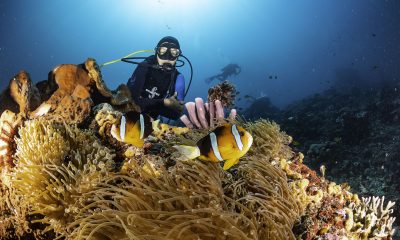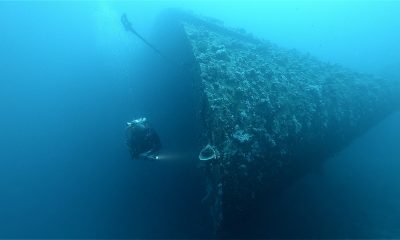Dive Training Blogs
Breathing for Scuba Divers: a blog by Steve Lewis
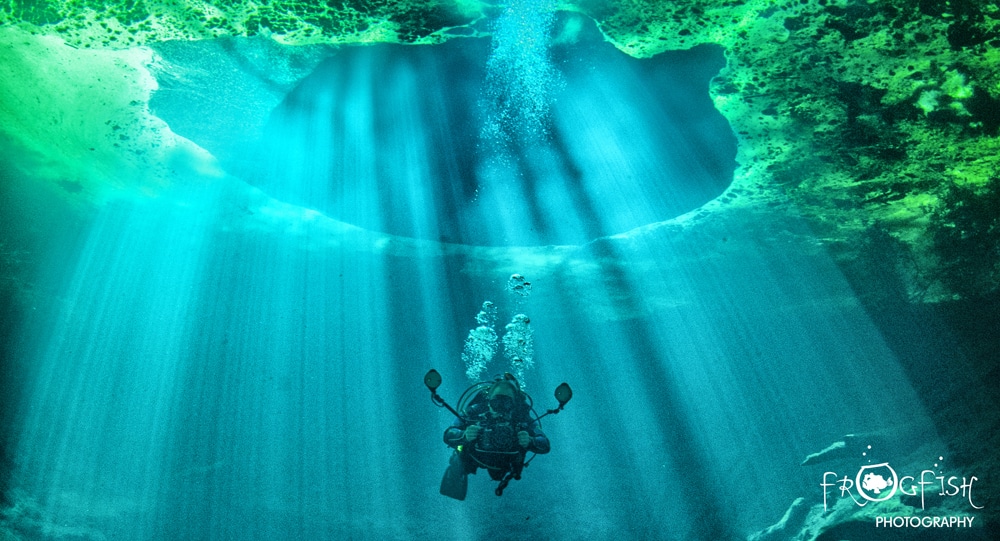
“Breathe in, breathe out, repeat as necessary; and by the way, don’t hold your breath because your lungs will explode and you’ll die!”
Sage advice from the gruff and taciturn ex-military type who was teaching us to dive back at the dawn of time. He was holding up one of those new-fangled, single-hose regulators as he spoke, explaining to a roomful of bright-eyed wanna-be divers the precise workings of scuba gear, and our role in making it deliver air at depth.
“Any questions?” He asked, looking around the room, shaking the regulator like a ferret with a rat, perhaps to show his attitude towards dissension or curiosity. The audience was quiet. “Good,” he said. “Let’s move on…”
So that was it. One of the first lessons on how to dive.
Trouble is, as far as teaching a critical skill — breathing underwater — it went no further than a fairy can throw a garden tractor. Memorable, yes. Informative, not so good; garden tractor in exactly the same spot as before.
Now fast forward a few years and let’s look at a student manual from a major sport-diving agency on the topic.
“Breathing underwater is just like breathing on the surface…” Really?!
Anyone who’s used scuba gear underwater will tell you that statement cannot possibly be true. In fact, even if you’ve never used scuba gear, and unless you’re a genetic mouth-breather with a seriously plugged nose, two seconds with a mask on your face and a second stage shoved in your mouth will show just how much of an untruth it is.
Leafing through that manual, and then thumbing through most of the other student manuals and dive books laying around the house, does not turn up much more information… well, it turns up none really. Advice on how to breathe on scuba is conspicuously absent. Odd when one considers that breathing is important, getting it wrong could be fatal (thank you BSAC instructor), and the number of posted questions on scuba forums with breath or breathing in the subject line out numbers those about sharks.
People want to know. Moreover, the people with questions are not all new divers.
A few weeks back a local dive shop hosted a “how-to-breathe-for-scuba-divers” workshop. It attracted a capacity crowd, and more than half that crowd were very experienced divers with technical certs of one sort or another… certainly not beginners.
It introduced to the crowd the concepts of using yoga and Tai-Chi breathing techniques to relax pre-dive. And it suggested using modifications of those techniques during the dive itself. The intended outcome: controlled breathing, relaxed divers, and everything related to those two things.
This approach — the “let’s learn to breathe” approach — brings up a clash of ideals. On one side we have the Sri Sri Ravi Shankar, all things Eastern and Mystical school of thought, and on the other it’s Bob’s bait and tackle shop, no-need for voodoo approach. It’s a sort of charcuterie from the meat department at Harrods vs packaged ham from Tesco Express argument.
I favour the thinly-sliced saucisson myself; and on that note, here are a couple of the techniques brought up and tried at that recent workshop.
The 4-7-8 (or Relaxing Breath) Exercise
As a relaxing exercise 4-7-8 breathing is effective and can be done anywhere. It’s my standard go-to before every dive, and on more complex ones, I use the modified version during the dive.
Place the tip of your tongue in the spot just behind your upper front teeth and keep it there. As you exhale through your mouth around your tongue the air makes a whoosh sound. This is correct.
- Close your mouth and inhale quietly through your nose to a mental count of four.
- Hold your breath for a count of seven.
- Exhale completely through your mouth, making a whoosh sound to a count of eight.
- This is one breath. Repeat the cycle as many times as you can.
Since holding your breath is NOT an option for scuba divers, the modified “diver’s version” replaces the breath hold with a pause, and of course all breathing is through the mouth.
Another pre-dive trick that is really relaxing is Breath Counting.
The Breath Counting Technique
This one is part of a bog-standard, no-frills, Zen Buddhist introduction to meditative and mindful practice.
You can do it anywhere, driving, walking, but the standard is to sit in a comfortable position with your back straight and head inclined slightly forward. Focus on a spot a couple of metres ahead or close your eyes and take a few deep breaths and try to clear your mind.
- To begin, breathe slowly and deeply and count “one” to yourself as you release your breath.
- The next time you exhale, count “two,” and so on up to “five.”
- Start a new cycle, by counting “one” on the next exhalation.
Don’t count higher than “five,” and count only when you exhale.
No need to modify it much for diving (keep your eyes open though), and I find it interesting to time my fin kicks — the thrusting action of my frog kick — with each exhalation.
The result of both of these will be better gas consumption, no CO2 build up, and a better dive experience.
And yet, in the final blow, one might ask: “Why bother?” The Tesco Express crowd are quite correct saying that there’s no secret to breathing… From their prospective, a slice of ham slapped inside a dinner roll is as satisfying as Pane Laterza stuffed with prosciutto crudo and cheese; a lot less bother to make too.
So, maybe the difference is all style and no substance; my viewpoint is admittedly too biased to be objective on that score. But a physiologist — a specialist in diving medicine as it happened — explained once: “You know, panic is virtually impossible if you can control your breathing… deep and slow. Control your breathing and the Flight-Flight-Freeze reaction is replaced by a kind of WTF! Let’s get this sorted, NOW! attitude; an attitude with a much better potential outcome.” She and I were talking about the best response to something hitting the fan while scuba diving.
I have always remembered that conversation. It made sense then and does now.
What do you think?
Steve Lewis’s new book, Death in Number Two Shaft: the underwater exploration of Newfoundland’s Bell Island Mine, is available now on Steve’s website or from Amazon UK.
Find out more about Steve at www.techdivertraining.org.
Blogs
Intro to Tech: What is it about?
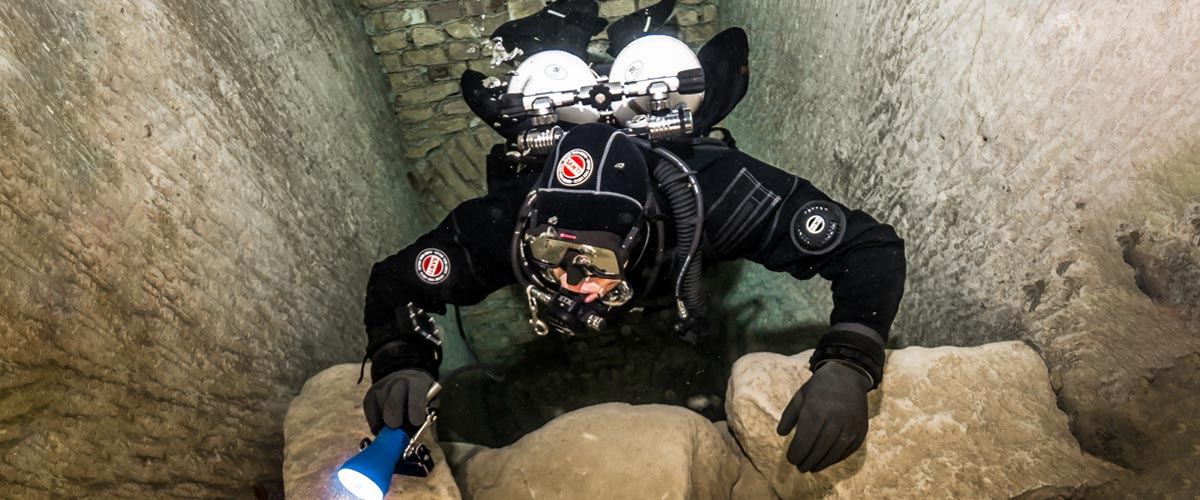
Article by José Pablo Mir
Pictures by Cezary Abramowski
The world of technical diving is exciting. It opens the door to new sites, depths, and bottom times. More importantly, it opens our minds to a new way of planning, facing, and experiencing dives, even those not purely technical.
Becoming a technical diver is a process, and like in other aspects of life, we should find the proper entry point that suits us best based on our knowledge and experience. The Introduction to Technical Diving course from TDI -the world’s largest and most recognized technical diving teaching organization- is the best option for divers who have yet to gain experience in the fundamental aspects of this new practice. The course’s content and its embrace of new techniques and technologies make it possible to acquire a solid foundation to learn and gain experience in this practice properly.
Becoming a technical diver is not something that happens overnight, whether deciding to become one or receiving a certification card stating we are now technical divers. It is a slow process extending farther away than any introductory course. It requires effort and dedication. But it will bring us satisfaction from day one -or two.
It is a matter of mentality
First, we must understand and accept that technical diving, involving greater depths, longer bottom times, exotic gases, virtual or real ceilings, and more, comes with higher levels of risk than the sport diving we have been practicing until now.
Although this discussion usually starts with a warning about risks, as I’ve done in the previous sentence, our practice is not a game of chance.
Technical diving is a rational activity that requires maturity and good judgment, and we will put everything into ensuring that each dive is a successful one -meaning we return from it safe and sound. With this understanding, we will strive to establish a mental attitude more aligned with our practice and its realities.
This new “technical diver” mindset we will develop will lead us to be more cautious in our executions, more analytical in our plans, more rational in our strategies, and more detailed in our procedures.
Experience will keep teaching us to know ourselves better, to keep our anxiety and other emotions under control, and to manage our impulses. Over time, our senses will sharpen, and we will be more attentive to the particulars of the situation we find ourselves in.
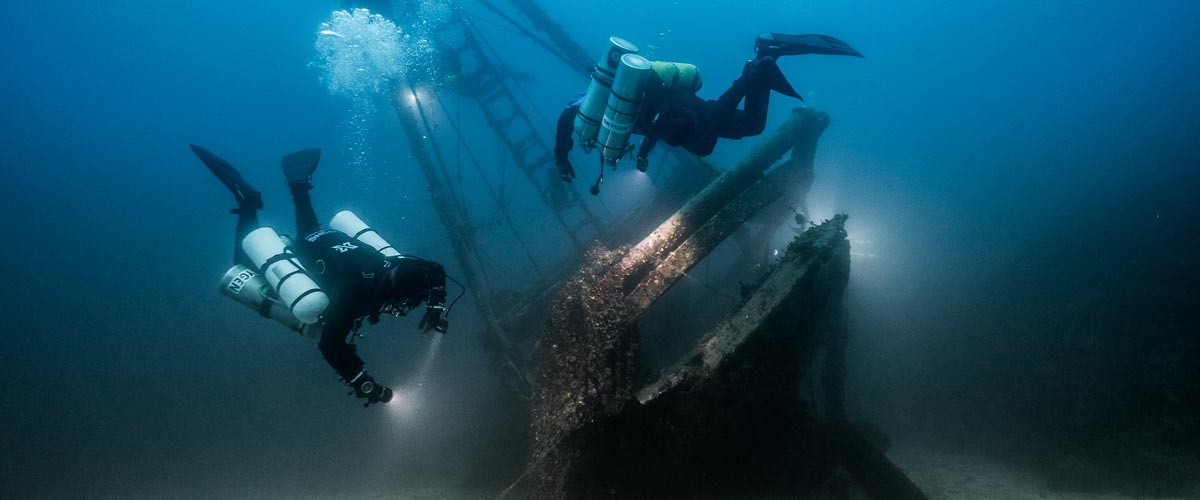
Strategies and procedures
Our strategies, those broad guiding lines tracing the path to follow, from how to approach planning to where, with what, and how we are willing to get there, will be more specific and more practical. Not because they magically become so, but because we will consciously and deliberately frame them that way.
We will establish clear, concise, and realistic procedures. Not only for the undesirable situations that may present themselves but also for those that are part of our dive objectives.
Even though, as technical divers, we often use equipment different from what we were previously accustomed to, it is essential to note that the gear does not make the diver. In a way, we could consider such equipment as the necessary tools to implement what our goal seeks to achieve, according to our strategies and procedures.
Technique plays an important role
We must put our greatest effort into learning and perfecting the different techniques we will be acquiring. Buoyancy, trim, propulsion, cylinder handling, deploying DSMBs and lift bags, valve drills, and more are essential skills we must begin to master to progress in our art. What we cannot do, when we need to do it, can harm us.
Our techniques must be effective and achieve the purpose for which they were devised. But they must also be efficient and require the least resources possible, including the time they take and the effort they demand. Effectiveness and efficiency will prevail over beauty and other considerations that may come to mind, although none of them should be mutually exclusive. A technique executed efficiently and effectively tends to have an inherent beauty.
Refining techniques is a lifelong mission. Some of them will be easy to master from the go; others, on the other hand, will be our life mission and will require many repetitions just to resemble the idea we have in mind of how they should be executed.
We must consider the environment
Our learning, the needs and musts of the practice we engage in, the experience we gradually gain, our strategies and procedures, and even our equipment and tools change with the environment.
Diving in the ocean, everything about us must be suitable for ocean dives. Conditions there rarely emulate those found in a pool, lake, or river. Variable winds and currents, greater depths, visibility conditions, other divers with uncertain skills around us, marine life, maritime traffic, distance from the coast, and many other factors add complexity and uncertainty.
It is never necessary to master the pool on the first day, but planning and aspiring to gradually cope with the ocean’s conditions is essential.
The cost of good training
We are aware that our resources are often scarce in relation to the possibilities of use we could give them if they were not. To a greater or lesser extent, we are part of the economic reality in which we are embedded.
Fortunately, the cost of good technical diver training is not an entry barrier. Comparing training and equipment costs, we see that the former are generally lower. Yes, lower cost for personalized service, essential to our future
performance and safety, than for a series of mass-produced products that are mere, albeit necessary, tools for an end.
The value of good training
The value of the training we received encompasses a range of characteristics, from emotional and methodological to technical and technological. TDI and its Introduction to Technical Diving course offer a deep and modern approach, with a teaching strategy that aims to create thinking divers, not merely obedient ones.
As technical divers, our knowledge is our primary tool. In this type of activity, what we don’t know can harm us.
Is this course optional?
Unfortunately, the fact that this Introduction to Technical Diving course is not a prerequisite for any subsequent training is an invitation to consider it optional. And we all know what usually happens to “optional” under budget constraints.
However, this course should be seen as optional only by those divers who are somehow familiar with the use of technical equipment, who have a mindset more in line with the requirements of this type of diving, who plan and execute the dives the proper “technical” way, who know their gas consumption rate, who are not intimidated by non-decompression tables, who feel comfortable using their dive computers, and know the techniques and have at least an acceptable level of buoyancy, positioning, and propulsion. Those can go straight to a more advanced training course, such as TDI’s Advanced Nitrox.
We must ask ourselves whether or not we are in that group.
Remember our goal: to have fun
Recreational diving is our passion. Jumping into the water carrying heavy equipment and having properly dotted our I’s and crossed our T’s have only one ultimate goal: fun. This is the activity we have chosen as a hobby. We must enjoy it; it must give us pleasure and make us vibrate.
Having a good time is not optional!
Blogs
Four opportunities to go pro in 2024 with Dive Friends Bonaire

Dive Friends teaches the Instructor Development Course (IDC) several times a year to students who are eager to share their passion for diving with the world.
Dive Friends is known for the personal approach throughout the course. Their in-house course director will lead the students through every essential step, mentoring them to achieve their fullest potential as a dive instructor.
Applications for the following IDC start dates are now open:
- 12 April
- 5 July,
- 20 September
- 29 November
Partnership with Casita Palma
If the student opts for the IDC-Deluxe or IDC-Supreme package, their accommodation will be arranged for them at Casita Palma. This small and quiet resort is within walking distance from Dive Friends Bonaire’s main dive shop location and has everything you need to relax after an intense day of IDC training. Breakfast is included, so the student will always be fuelled and ready for their day.
Contact Dive Friends Bonaire’s Course Director Eddy for more information: coursedirector@divefriendsbonaire.com.
-

 News3 months ago
News3 months agoHone your underwater photography skills with Alphamarine Photography at Red Sea Diving Safari in March
-

 News2 months ago
News2 months agoCapturing Critters in Lembeh Underwater Photography Workshop 2024: Event Roundup
-

 Marine Life & Conservation Blogs2 months ago
Marine Life & Conservation Blogs2 months agoCreature Feature: Swell Sharks
-

 Blogs2 months ago
Blogs2 months agoMurex Resorts: Passport to Paradise!
-

 Blogs2 months ago
Blogs2 months agoDiver Discovering Whale Skeletons Beneath Ice Judged World’s Best Underwater Photograph
-

 Gear News3 months ago
Gear News3 months agoBare X-Mission Drysuit: Ideal for Both Technical and Recreational Divers
-

 Gear Reviews2 months ago
Gear Reviews2 months agoGear Review: Oceanic+ Dive Housing for iPhone
-

 Marine Life & Conservation2 months ago
Marine Life & Conservation2 months agoSave the Manatee Club launches brand new webcams at Silver Springs State Park, Florida






